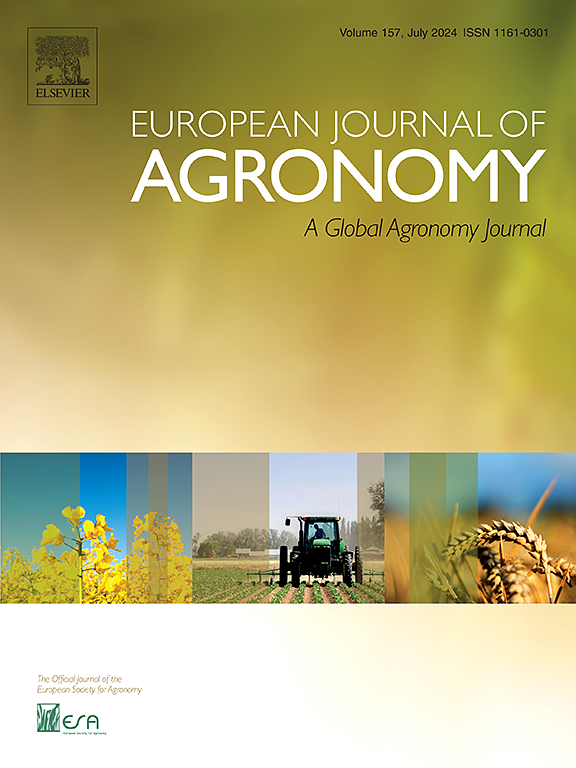黄淮海平原冬小麦有机肥替代无机肥的能源、环境足迹和经济效益
IF 4.5
1区 农林科学
Q1 AGRONOMY
引用次数: 0
摘要
粪肥替代在氮(N)管理、粮食安全、能源平衡和降低环境成本方面大有可为。然而,黄淮海平原对这一做法的研究有限。本研究旨在调查 2017 年至 2019 年冬小麦在两种氮肥(U,尿素;M,有机肥)、两种施肥量(180 千克氮/公顷,U1 为 100%尿素,M1 为 100%有机肥;90 千克氮/公顷,U2 为 50%尿素,M2 为 50%有机肥)和不施肥处理(CK)下的能源利用效率、经济效益、碳足迹和氮足迹。结果表明,施氮量为每公顷 90 千克时,粮食产量和农业投入成本分别比施氮量为每公顷 180 千克时低 15.5%和 7.8%,导致经济效益显著下降。在相同施氮量下,M1 的谷物产量高于 U1,M2 的谷物产量与 U2 没有差异。M 的总能源投入和农业投入成本分别比 U 低 9.5 % 和 3.6 %,从而提高了能源利用效率和经济效益。M 减少农业投入的主要原因是减少了无机肥料的施用量。与其他处理相比,U2+M2 获得了更高的谷物产量、能源利用效率和经济效益。U1 谷物单位产量的碳足迹增加了 13.7%-24.1%,氮足迹增加了 3.9%-19.6%,其原因是农业投入增加了直接一氧化二氮排放、间接碳排放和活性氮损失。总体而言,U2+M2 保持了较高的生产率,并减少了对环境的影响。在黄淮海平原,用有机肥替代无机肥料是一种以较少农业投入和环境足迹提高农业产量的可行策略。本文章由计算机程序翻译,如有差异,请以英文原文为准。
Energy, environmental footprints and economic benefit of substituting inorganic fertilizer with organic manure for winter wheat in Huanghuaihai Plain
Manure substitution shows promise for nitrogen (N) management, food security, energy balance and environmental costs reduction. However, there is limited research on this practice in the Huanghuaihai Plain. This study aimed to investigate the energy use efficiency, economic benefits, carbon and nitrogen footprint under two types of N fertilizer (U, urea and M, organic manure), two application rates of N (180 kg N ha−1, U1 for 100 % urea and M1 for 100 % organic manure; 90 kg N ha−1, U2 for 50 % urea and M2 for 50 % organic manure) and no fertilizer application treatment (CK) for winter wheat from 2017 to 2019. Results showed that grain yield and agricultural input cost under N application rate of 90 kg N ha−1 was 15.5 % and 7.8 % lower than that of 180 kg N ha−1, respectively, leading to a significant decrease in economic benefit. Under the same N rate, M1 obtained higher grain yield than U1, grain yield of M2 did no differ in that of U2. Total energy inputs and agricultural input costs of M were 9.5 % and 3.6 % lower than U, resulting in higher energy use efficiency and economic benefit. The reduced agricultural input for M was primarily due to a decrease in the application of inorganic fertilizer. Compared with other treatments, U2+M2 obtained higher grain yield, energy use efficiency, and economic benefit. The carbon and nitrogen footprint on unit grain yield of U1 was increased by 13.7 %-24.1 % and 3.9 %-19.6 %, which was attributed to the increase in direct N2O emissions, indirect carbon emission and losses of reactive N from agricultural inputs. Overall, U2+M2 sustained high productivity and reduced the environmental impact. Substituting inorganic fertilizer with organic manure was a promising strategy to improve agricultural production with less agricultural inputs and environmental footprints in the Huanghuaihai Plain.
求助全文
通过发布文献求助,成功后即可免费获取论文全文。
去求助
来源期刊

European Journal of Agronomy
农林科学-农艺学
CiteScore
8.30
自引率
7.70%
发文量
187
审稿时长
4.5 months
期刊介绍:
The European Journal of Agronomy, the official journal of the European Society for Agronomy, publishes original research papers reporting experimental and theoretical contributions to field-based agronomy and crop science. The journal will consider research at the field level for agricultural, horticultural and tree crops, that uses comprehensive and explanatory approaches. The EJA covers the following topics:
crop physiology
crop production and management including irrigation, fertilization and soil management
agroclimatology and modelling
plant-soil relationships
crop quality and post-harvest physiology
farming and cropping systems
agroecosystems and the environment
crop-weed interactions and management
organic farming
horticultural crops
papers from the European Society for Agronomy bi-annual meetings
In determining the suitability of submitted articles for publication, particular scrutiny is placed on the degree of novelty and significance of the research and the extent to which it adds to existing knowledge in agronomy.
 求助内容:
求助内容: 应助结果提醒方式:
应助结果提醒方式:


